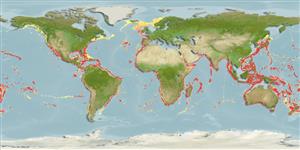Environment: milieu / climate zone / depth range / distribution range
Écologie
marin benthopélagique; profondeur 200 - 1200 m (Ref. 6181). Deep-water; 70°N - 47°S, 180°W - 180°E
Probably distributed worldwide in tropical and subtropical seas except in eastern Pacific and northern Indian oceans. Large-sized individuals stray in cold-temperate waters off Iceland, Norway, northern Japan and southern New Zealand (Ref. 6181). Reported from 19°41'S, 79°11'W (Ref. 11892).
Taille / Poids / Âge
Maturity: Lm ? range ? - ? cm
Max length : 130 cm SL mâle / non sexé; (Ref. 6181); common length : 80.0 cm SL mâle / non sexé; (Ref. 6181)
Épines dorsales (Total): 20 - 22; Rayons mous dorsaux (Total): 19-24; Épines anales 2; Rayons mous anaux: 18 - 21; Vertèbres: 34 - 36. Body fairly elongate and strongly compressed. Mouth with fang-like teeth. The tips of both jaws with dermal processes. Gill rakers degenerated. Color is dark brown with violet tint; fin membranes black; margin of anus black (Ref. 6181).
Adults, benthopelagic to mesopelagic, dwell on the continental slope or underwater rises, migrating to midwater at night (Ref. 6181). Eggs are pelagic (Ref. 6766). Larvae and juveniles, epipelagic to mesopelagic, are rather common in oceanic ichthyoplankton and are only found in the tropics (Ref. 6181). Feed on squid, fish and crustaceans (Ref. 6181). Consumed as food (Ref. 4537).
Life cycle and mating behavior
Maturité | Reproduction | Frai | Œufs | Fécondité | Larves
Nakamura, I. and N.V. Parin, 1993. FAO Species Catalogue. Vol. 15. Snake mackerels and cutlassfishes of the world (families Gempylidae and Trichiuridae). An annotated and illustrated catalogue of the snake mackerels, snoeks, escolars, gemfishes, sackfishes, domine, oilfish, cutlassfishes,. scabbardfishes, hairtails, and frostfishes known to date. FAO Fish. Synop. 125(15):136 p. (Ref. 6181)
Statut dans la liste rouge de l'IUCN (Ref. 130435)
Menace pour l'homme
Harmless
Utilisations par l'homme
Pêcheries: intérêt commercial mineur
Plus d'informations
RéférencesAquacultureProfil d'aquacultureSouchesGénétiqueElectrophoresesHéritabilitéPathologiesTraitementNutrientsMass conversion
Outils
Articles particuliers
Télécharger en XML
Sources Internet
Estimates based on models
Preferred temperature (Ref.
123201): 6.6 - 14.3, mean 9.6 °C (based on 988 cells).
Phylogenetic diversity index (Ref.
82804): PD
50 = 1.0000 [Uniqueness, from 0.5 = low to 2.0 = high].
Bayesian length-weight: a=0.00363 (0.00163 - 0.00807), b=3.10 (2.91 - 3.29), in cm total length, based on LWR estimates for this (Sub)family-body shape (Ref.
93245).
Niveau trophique (Ref.
69278): 4.3 ±0.71 se; based on food items.
Résilience (Ref.
120179): Faible, temps minimum de doublement de population : 4,5 à 14 années (Preliminary K or Fecundity.).
Fishing Vulnerability (Ref.
59153): Very high vulnerability (90 of 100).
Nutrients (Ref.
124155): Calcium = 10.7 [5.1, 22.9] mg/100g; Iron = 0.283 [0.121, 0.617] mg/100g; Protein = 16.5 [14.4, 18.5] %; Omega3 = 0.266 [0.107, 0.654] g/100g; Selenium = 20.2 [5.3, 65.7] μg/100g; VitaminA = 14.7 [3.3, 68.7] μg/100g; Zinc = 0.266 [0.129, 0.522] mg/100g (wet weight);
